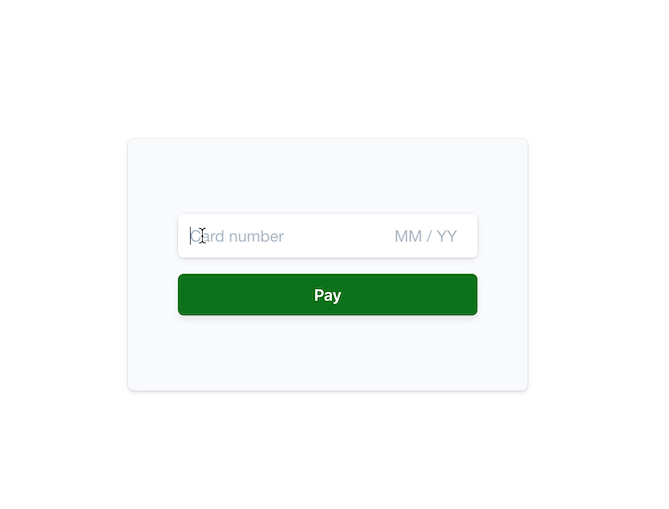Charging a card consists of three steps:
🕵️ Authentication - Card information is sent to the card issuer for verification. Some cards may require the cardholder to strongly authenticate the purchase through protocols like 3D Secure.
💁 Authorization - Funds from the customer's account are put on hold but not transferred to the merchant.
💸 Capture - Funds are transferred to the merchant's account and the payment is complete.
The Payment Intents API abstracts away these three stages by handling all steps of the process through the confirm method. After you create a PaymentIntent, call confirm to authenticate, authorize, and capture the funds in one API call.
Demo
Web: See a hosted version of the sample or fork a copy on codesandbox.io
Mobile: Run the sample locally
All the samples run in test mode -- use 4242424242424242 as a test card number with any CVC code + a future expiration date.
Use the 4000000000003220 test card number to trigger a 3D Secure challenge flow.
Read more about testing on Stripe at https://stripe.com/docs/testing.
There are two implementations depending on whether you want to use webhooks for any post-payment process:
- /using-webhooks Confirms the payment on the client and requires using webhooks or other async event handlers for any post-payment logic (e.g. sending email receipts, fulfilling orders).
- /without-webhooks Confirms the payment on the server and allows you to run any post-payment logic right after.
This sample shows:
| Using webhooks | Without webhooks | |
|---|---|---|
| 💳 Collecting card and cardholder details. Both integrations use Stripe Elements to build a custom checkout form. | ✅ | ✅ |
| 🙅 Handling card authentication requests and declines. Attempts to charge a card can fail if the bank declines the purchase or requests additional authentication. | ✅ | ✅ |
| ↪️ Using webhooks to respond to a successful payment. Confirming the payment on the client requires using webhooks for any follow up actions, like emailing a receipt. | ✅ | ❌ |
| 🏦 Easily scalable to other payment methods. Webhooks enable easy adoption of other asynchroneous payment methods like direct debits and push-based payment flows. | ✅ | ❌ |
This sample includes 5 server implementations in Node, Ruby, Python, Java, and PHP for the two integration types: using-webhooks and without-webhooks.
Follow the steps below to run locally.
1. Clone and configure the sample
The Stripe CLI is the fastest way to clone and configure a sample to run locally.
Using the Stripe CLI
If you haven't already installed the CLI, follow the installation steps in the project README. The CLI is useful for cloning samples and locally testing webhooks and Stripe integrations.
In your terminal shell, run the Stripe CLI command to clone the sample:
stripe samples create accept-a-card-payment
The CLI will walk you through picking your integration type, server and client languages, and configuring your .env config file with your Stripe API keys.
Installing and cloning manually
If you do not want to use the Stripe CLI, you can manually clone and configure the sample yourself:
git clone https://github.com/stripe-samples/accept-a-card-payment
Copy the .env.example file into a file named .env in the folder of the server you want to use. For example:
cp .env.example using-webhooks/server/node/.env
You will need a Stripe account in order to run the demo. Once you set up your account, go to the Stripe developer dashboard to find your API keys.
STRIPE_PUBLISHABLE_KEY=<replace-with-your-publishable-key>
STRIPE_SECRET_KEY=<replace-with-your-secret-key>
STATIC_DIR tells the server where to the client files are located and does not need to be modified unless you move the server files.
2. Follow the server instructions on how to run:
Pick the server language you want and follow the instructions in the server folder README on how to run.
For example, if you want to run the Node server in using-webhooks:
cd using-webhooks/server/node # there's a README in this folder with instructions
npm install
npm start
3. [Optional] Run a webhook locally:
If you want to test the using-webhooks integration with a local webhook on your machine, you can use the Stripe CLI to easily spin one up.
First install the CLI and link your Stripe account.
stripe listen --forward-to localhost:4242/webhook
The CLI will print a webhook secret key to the console. Set STRIPE_WEBHOOK_SECRET to this value in your .env file.
You should see events logged in the console where the CLI is running.
When you are ready to create a live webhook endpoint, follow our guide in the docs on configuring a webhook endpoint in the dashboard.
4. [Mobile clients] Set up the client app:
Finally, choose a mobile client implementation and follow the instruction in the app's README (e.g. using-webhooks/client/ios/README.md) to run.
When the app is running, use 4242424242424242 as a test card number with any CVC code + a future expiration date.
Use the 4000000000003220 test card number to trigger a 3D Secure challenge flow.
Read more about testing on Stripe at https://stripe.com/docs/testing.
Q: Why did you pick these frameworks?
A: We chose the most minimal framework to convey the key Stripe calls and concepts you need to understand. These demos are meant as an educational tool that helps you roadmap how to integrate Stripe within your own system independent of the framework.
Q: Can you show me how to build X?
A: We are always looking for new sample ideas, please email dev-samples@stripe.com with your suggestion!
